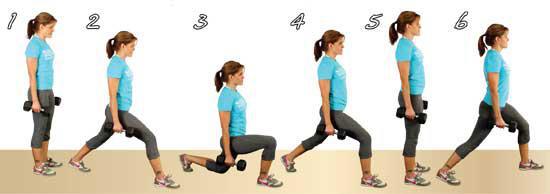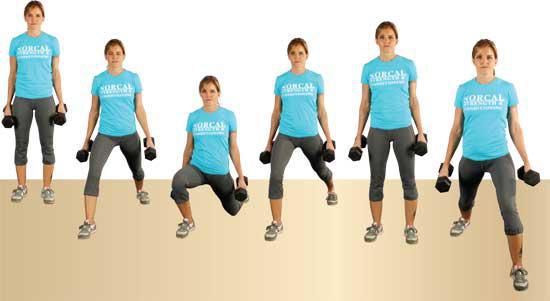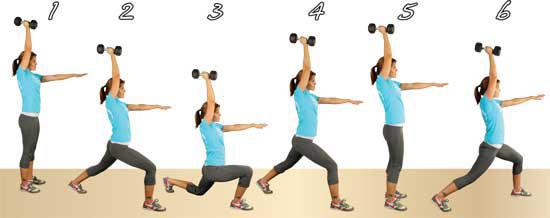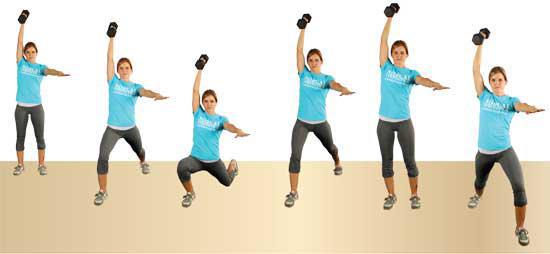Everyday Paleo (50 page)
Authors: Sarah Fragoso
Tags: #Diets, #Healthy Living, #Health & Fitness, #General
1)
Raise the dumbbells to your shoulders so that your elbows are high and pointing directly in front of you. Your feet should be positioned directly under your shoulders, just as with the regular air squat. Make sure you stabilize your midsection by tightening your tummy muscles before you start this movement.
2)
Begin to reach your fanny back, keeping your tummy tight, elbows high, and chest upright.
3)
Perform a full depth squat while maintaining a tight tummy, high elbows, and upright chest.
4)
Keep your chest upright, push through your heels and return to the standing position. As you do this, it is important not to let the weights drag you forward.
5)
Finish the movement by standing all the way upright. Leave the dumbbells on your shoulders and repeat.

Thrusters
This movement is a dynamic combination of the dumbbell squat and the dumbbell press. As with some of the previous exercises, it’s a more advanced movement and should only be attempted once you are comfortable with a dumbbell squat. With the added weight of a set of dumbbells, you must not only move from a squat position to a standing position, but you must also simultaneously move the dumbbells overhead. Although this movement might sound easy enough, thrusters are sure to give you a wake-up call in the intensity department!
MUSCLES USED: Quadriceps, Gluteals, Hamstrings, Deltoids, and Triceps

1)
Bring the dumbbells up to your shoulders. You want to assume the start position for a dumbbell squat, meaning your elbows are high, your feet are under your shoulders, and your tummy is tight.
2)
To begin the dumbbell squat, reach your fanny back and bend at the knees. Remember to stay tight, keep those elbows high, and keep your chest up.
3)
Make sure to reach full depth in the squat.
4)
At the bottom of your squat, push quickly and powerfully up through your heels, as if you are jumping. As you drive up through your heels, let the power that you generate from your legs and fanny help you explode the dumbbells straight overhead. The squat and press should not be two separate movements, but rather one fluid movement. The dumbbells should start to push overhead before you are completely back to a standing position.
5)
Once you are standing, finish with your arms fully extended and the dumbbells lined up over your shoulders, hips, and heels, just as with the dumbbell press.
6)
As you lower the dumbbells back to your shoulders, begin to drop back into another squat.
7)
Finish back in the full-depth squat position and repeat the movement. It is important to find a rhythmic breathing pattern during this movement. You want to keep your midsection stabilized and strong, but because this is a high-intensity movement, you are still going to need your breath.

Weighted Walking Lunge
Once you have mastered a full-depth squat and feel comfortable with walking lunges, you are ready to try the weighted walking lunge. With a dumbbell in each hand, it adds resistance and intensity to this awesome fanny burning movement.
MUSCLES USED: Gluteals, Hamstrings, Quadriceps, and Adductors

1)
Start in the same position as a squat, with your feet under your shoulders and holding the dumbbells down at your sides. Do not allow the dumbbells to pull your shoulders forward. Instead, squeeze your shoulder blades together and keep your chest up.
2)
Keeping your torso upright, your gaze forward, and the dumbbells held close to your body, take a giant step forward with your right foot. If you look at the photo, you’ll notice I move my foot a little toward one o’clock. This will help you to maintain balance.
3)
Making sure to keep your chest upright and your tummy tight, lower your left knee straight down. The shin of your front leg should stay vertical with your knee and track over your heel, not your toes. Your back knee should continue to sink down until it’s just above the ground.
4)
Pushing up through the heel of your front leg, begin your return to a vertical position. You should feel this movement in your fanny as you rise.
5)
Return to the start position by stepping your left foot up to your right foot. Your feet should be positioned under your shoulders and your tummy should remain tight.
6)
Repeat the movement exactly as described, but this time step forward with the opposite leg. Continue to lunge, alternating legs as you go.

Overhead Dumbbell Lunge
The overhead dumbbell lunge is similar to the walking weighted lunge, but instead of holding two dumbbells at your sides, you hold a single dumbbell over your head. As a result, the movement works the shoulders and arm muscles, as well as the glutes, quads, hamstrings, and core. It is important to note that the movement requires torso stability and balance, so if the walking lunge still proves to be challenging, hold off on this movement until you can perform the basic walking lunge as well as the weighted walking lunge with ease. In addition, make sure to use lighter weight when first starting out with this advanced movement.
MUSCLES USED: Gluteals, Hamstrings, Quadriceps, Adductors, Deltoids, Trapezius, and Core

1)
Begin the movement with the right dumbbell extended directly overhead and your left arm held straight out in front of you for balance.
2)
Keeping the dumbbell extended straight overhead, your torso tight, your gaze directed forward, and your left arm extended out in front of you for balance, take a giant step forward with your right foot. If you look at the photos, you’ll notice I step toward one o’clock. This will help you to maintain balance. Since added weight is involved in this movement, it is important to start slowly at first in order to maintain balance and allow yourself to get used to the feel of lunging while holding something overhead.
3)
Slowly lower your left knee toward the ground. The shin of your front leg should stay vertical with your knee and track over your heel, not your toe. The back knee should continue to sink down until it’s just above the ground.
4)
Pushing up through the heel of your front leg, begin your return to a vertical position. You should feel this movement in your fanny as you rise.
5)
Step your left foot up to your right foot, returning to the start position. Your feet should be under your shoulders and your tummy should remain tight.
6)
Repeat the movement exactly as described, but this time step forward with your opposite leg. Continue to lunge, alternating legs as you go. Make sure that you switch arms after performing a predetermined amount of lunges.
